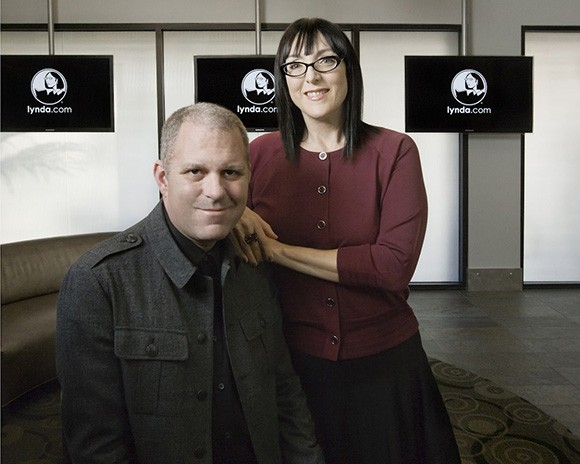Customer list, library drive $1.5B merger
IN THIS ARTICLE
- Latest news Topic
- Erika Martin Author
By Erika Martin Friday, April 17th, 2015

Lynda.com Co-founder and Chief Innovation Officer Bruce Heavin and co-founder and Executive Chair Lynda Weinman at the company’s Carpinteria headquarters. (Business Times file photo)
Making a $1.5 billion bet on building an economic map to connect professionals across the globe, social networking platform LinkedIn is acquiring Carpinteria-based Lynda.com in a cash and stock deal.
Based in Mountain View, LinkedIn has joined the ranks of social media behemoths by focusing on career development and networking. The acquisition of Lynda.com will give it access to the South Coast company’s library of training videos and its global customer base, which it hopes to expand to offer corporate education and professional certification.
LinkedIn stock traded up 0.75 percent to $254.14 the day the deal was announced.
Lynda.com, one of the fastest-growing firms in the Tri-Counties, generated $150 million in revenue in 2014. It has been profitable since two years after its founding in Ojai in 1995. The company is headquartered on a 12-acre campus in Carpinteria, with additional California offices in San Francisco and Calabasas.
Neither firm has released information on the fate of Lynda.com’s Carpinteria headquarters or the company’s roughly 600 employees. The deal is expected to close mid-year.
It is the second largest tech acquisition in the tri-county region’s history, after the $6.9 billion purchase of Santa Barbara-based Software.com. Phone.com bought Software.com in an all-stock deal in August 2000, a few months after the dot-com bubble had begun to burst.
The Lynda.com deal compares in size with only two other Silicon Valley acquisitions in the past five years: Yahoo’s 2013 purchase of Tumblr for $1.1 billion and Facebook’s 2012 purchase of Instagram for $1 billion. It also makes Lynda.com the first tri-county member of the “unicorn club” of billion-dollar startups. Only two others have female founders: Gilt Groupe and Fab.
“It’s staggering when you look at the value of tech acquisitions period, much less women-owned companies,” said Kathy Odell, CEO of NutraHealth Partners. “It’s highly unusual to have a woman as founder and head. It puts her in pretty rare air.”
The sale caps a year of fast-paced activity for co-founders Lynda Weinman and her husband Bruce Haven. In January, a $186 million private equity investment round led by TPG Capital allowed the company to restructure and roll out new products aimed at boosting its subscription-based service while remaining private. It was only the second time the company had taken outside funding, and it allowed TPG Principal David Trujillo to join Lynda.com’s board of directors.
Michael Pfau, an attorney at Reicker, Pfau, Pyle & McRoy LLP who is not involved in the deal, said the acquisition was unexpected and unusual considering Lynda.com’s closely held status.
“It’s fascinating to see a company sell at that size with so much of the company still owned by original founders,” he said. “No doubt [the private equity investment] was a motivating factor. They’re in a very, very hot space so I suspect that money that came in was late-stage money and they were looking in the next 12 months at an IPO.”
Pfau also said that Lynda.com’s library of more than 250,000 training videos will help answer questions of how LinkedIn will drive revenue, with its existing services in a stasis.
“Certainly the online education space is a natural fit for them and it’s a natural growth direction for them, and one that should help build revenue,” Pfau said.
Odell said LinkedIn has struggled to drive regular traffic and the addition of Lynda.com’s services could change that.
“You don’t go onto LinkedIn all the time, you log in if someone sends you a request or you want to look someone up,” Odell said. “This gives them the opportunity to now be offering things that go both ways.”
Lynda.com started as a self-teaching resource for creative professionals looking to learn Web design and other software, but has since become a major player in supplying instructional materials to government, educational and business groups. Half of its clients are higher education and government entities, while the other half consists of corporate enterprises, including names like Google, Yahoo, Apple and Adobe.
In an April 9 conference call with investors, LinkedIn Chief Financial Officer Steve Sordello said the company has a long-term focus on the acquisition and will build on Lynda.com’s existing library of 6,000 courses to offer corporate education and professional certification programs.
“The learning and development landscape has become increasingly attractive over time,” Sordello said. “With the acquisition of Lynda.com, we expand our addressable opportunity by $30 billion into a market that includes corporate employee education and professional certifications.”
During the call, LinkedIn CEO Jeff Weiner said the company had been looking to move into learning and development for some time and identified Lynda.com because its mission is aligned with its own.
“Lynda.com helps you learn the skill you need to achieve your full potential. LinkedIn connects the world’s professionals to make them more productive and successful,” Weiner said. “The service can create even more economic opportunity when integrated with the hundreds of millions of people and millions of jobs available on LinkedIn.”
There was no bidding process and deal was the result of discussions directly between the two companies. Weiner said the acquisition also takes LinkedIn one step closer to its goal of creating an online network that is truly representative of the global economy.
“Our ultimate vision is to develop the world’s first economic graph,” Weiner said. “In other words, we want to digitally map the global economy, identifying the connections between people, companies, jobs, skills, higher education organizations and professional knowledge, and allow all forms of capital — intellectual capital, financial capital, human capital — to flow to where it can best be leveraged.”












